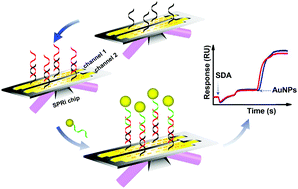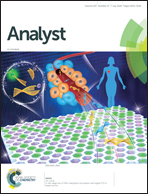A highly sensitive SPRi biosensing strategy for simultaneous detection of multiplex miRNAs based on strand displacement amplification and AuNP signal enhancement†
Abstract
Herein, a dual channel surface plasmon resonance imaging (SPRi) biosensor has been developed for the simultaneous and highly sensitive detection of multiplex miRNAs based on strand displacement amplification (SDA) and DNA-functionalized AuNP signal enhancement. In the presence of target miRNAs (miR-21 or miR-192), the miRNAs could specifically hybridize with the corresponding hairpin probes (H) and initiate the SDA, resulting in massive triggers. Subsequently, the two parts of the released triggers could hybridize with capture probes (CP) and DNA-functionalized AuNPs, assembling DNA sandwiches with great mass on the chip surface. A significantly amplified SPR signal readout was achieved. This established biosensing method was capable of simultaneously detecting multiplex miRNAs with a limit of detection down to 0.15 pM for miR-21 and 0.22 pM for miR-192. This method exhibited good specificity and acceptable reproducibility. Moreover, the developed method was applied to the determination of target miRNAs in a complex matrix. Thus, this developed SPRi biosensing method may present a potential alternative tool for miRNA detection in biomedical research and clinical diagnosis.



 Please wait while we load your content...
Please wait while we load your content...